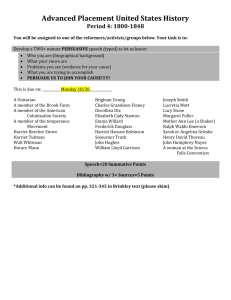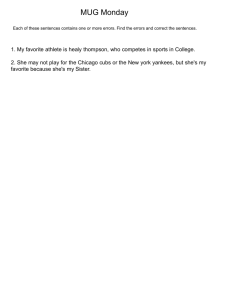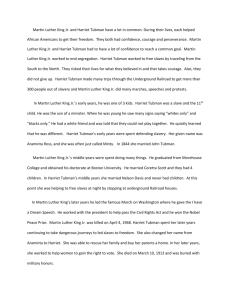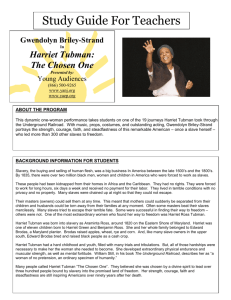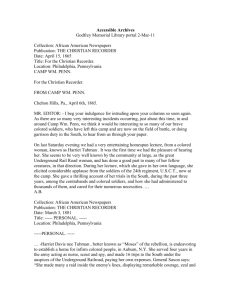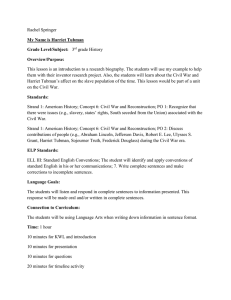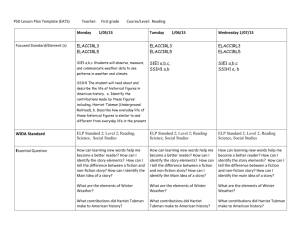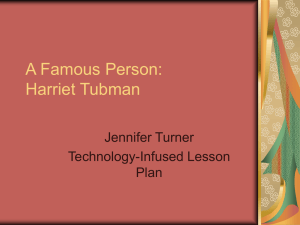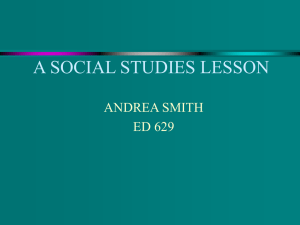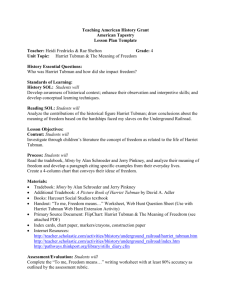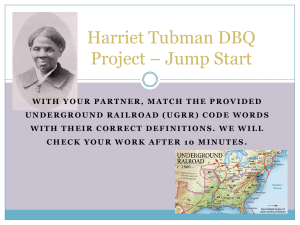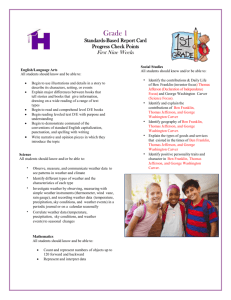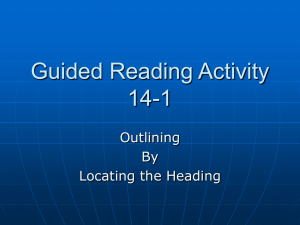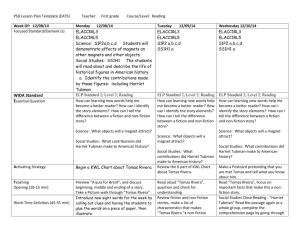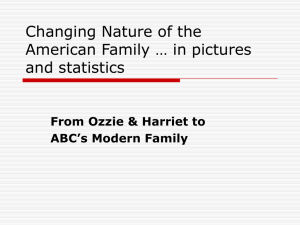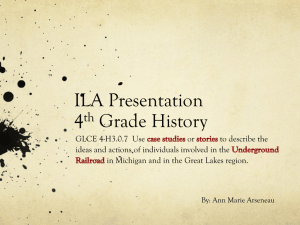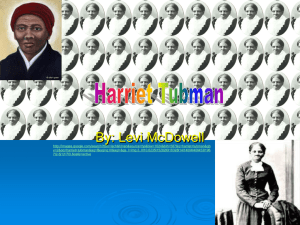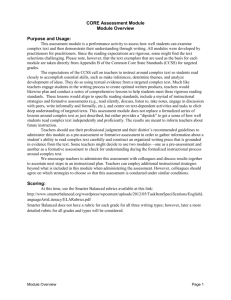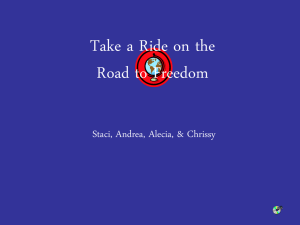Shifted_lessons_Social_Studies_February_2011
advertisement
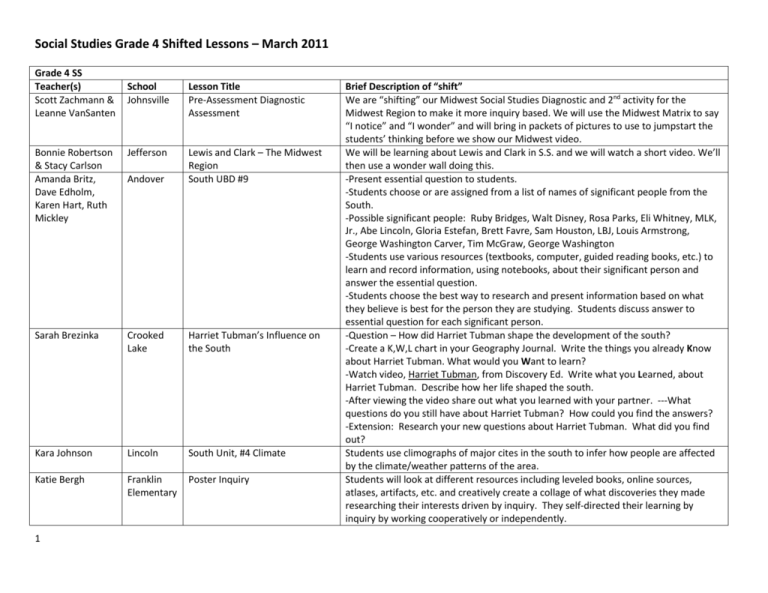
Social Studies Grade 4 Shifted Lessons – March 2011 Grade 4 SS Teacher(s) Scott Zachmann & Leanne VanSanten School Johnsville Lesson Title Pre-Assessment Diagnostic Assessment Bonnie Robertson & Stacy Carlson Amanda Britz, Dave Edholm, Karen Hart, Ruth Mickley Jefferson Andover Lewis and Clark – The Midwest Region South UBD #9 Sarah Brezinka Crooked Lake Harriet Tubman’s Influence on the South Kara Johnson Lincoln South Unit, #4 Climate Katie Bergh Franklin Elementary Poster Inquiry 1 Brief Description of “shift” We are “shifting” our Midwest Social Studies Diagnostic and 2nd activity for the Midwest Region to make it more inquiry based. We will use the Midwest Matrix to say “I notice” and “I wonder” and will bring in packets of pictures to use to jumpstart the students’ thinking before we show our Midwest video. We will be learning about Lewis and Clark in S.S. and we will watch a short video. We’ll then use a wonder wall doing this. -Present essential question to students. -Students choose or are assigned from a list of names of significant people from the South. -Possible significant people: Ruby Bridges, Walt Disney, Rosa Parks, Eli Whitney, MLK, Jr., Abe Lincoln, Gloria Estefan, Brett Favre, Sam Houston, LBJ, Louis Armstrong, George Washington Carver, Tim McGraw, George Washington -Students use various resources (textbooks, computer, guided reading books, etc.) to learn and record information, using notebooks, about their significant person and answer the essential question. -Students choose the best way to research and present information based on what they believe is best for the person they are studying. Students discuss answer to essential question for each significant person. -Question – How did Harriet Tubman shape the development of the south? -Create a K,W,L chart in your Geography Journal. Write the things you already Know about Harriet Tubman. What would you Want to learn? -Watch video, Harriet Tubman, from Discovery Ed. Write what you Learned, about Harriet Tubman. Describe how her life shaped the south. -After viewing the video share out what you learned with your partner. ---What questions do you still have about Harriet Tubman? How could you find the answers? -Extension: Research your new questions about Harriet Tubman. What did you find out? Students use climographs of major cites in the south to infer how people are affected by the climate/weather patterns of the area. Students will look at different resources including leveled books, online sources, atlases, artifacts, etc. and creatively create a collage of what discoveries they made researching their interests driven by inquiry. They self-directed their learning by inquiry by working cooperatively or independently. Grade 4 SS Teacher(s) Amy Sundem and Abby Payeur 2 School Sand Creek Lesson Title Immigration Simulation Brief Description of “shift” As a culminating activity, our entire grade level set up an “Ellis Island Simulation Day”. Students came to school dressed as an immigrant and were given a passport to travel to Ellis Island. We loaded the ship in the gym serving crackers and water to First Class passengers only. Second and Third class were in roped sections feeling cramped and uncomfortable. After the journey across the Atlantic, the kids got off the ship and circled through our classrooms experiencing a job interview, medical examination, etc... Some of the kids even got deported! Overall, the day was very successful and even emotional for some students. However, an experience our 4th grade students will never forget! Social Studies Grade 5 Shifted Lessons – March 2011 Grade 5 SS Teacher(s) Jodi Schwab School Johnsville Lesson Title Early Settlements Map – Introduction to Colonization Robin Parks Jefferson American Colonies Judy Curtiss Sand Creek Slavery in the Southern Colonies (Text 213-215) Jennifer Bicknese Crooked Lake Encounter Brief Description of “shift” Map will include: shading for New Spain, New France and the British Colonies, dots for St. Augustine, Roanoke, Jamestown, Plymouth and Quebec, all words and the title will be missing. Partners will do an I notice/I wonder T chart in their journal, so the shift will have: text after observation, group work, use of journals and students will be asking open-ended questions. Use of overview video rather than book first and the use of journals for all notes, observation, and questions. We started by talking and generating a list about what we know about slavery. Next I gave students a packet of narratives from the book To Be A Slave by Julius Lester. Students then worked in groups and wrote down and discussed, I Think and I Wonder statements based on the narratives. Students then read the text to see if the accounts of slavery differed or if they were able to make connections between the narratives and the text. Rather than just reading the story and having a teacher lead group discussion we read the story in parts and had students record their thoughts in their journals. We asked that they put themselves in the position of the Tiano people and asked them to answer the following questions as we paused. 1. What do you think these people want? 2. How do you feel? 3. What are you going to do? Deb Cordes 3 Sand Creek Benjamin Franklin was a Pretty Big Deal The students answered the questions as the Tiano people. Students in one of my classes had a huge interest in Ben Franklin and his inventions. We created our I Noticed/I Wonder list in our notebooks, then spent some time with a Discovery Ed video on Ben, and also investigated some pictures books/nonfiction books about Franklin. We decorated our journals and shared them in our class. We also started a list of his accomplishments that students have added to as they find more information about him. Grade 5 SS Teacher(s) David Reines School Monroe Lesson Title Colonization / New Amsterdam Brief Description of “shift” In small groups students read articles from the Smithsonian National Museum of the American Indian, taking notes and jotting down questions in Journals. Article 1 Manahatta – background info on the Native Americans living in the area of Manhattan in the 1500’s . Article 2 Manahatta Changed – Information on the Lenape Indians first encounter with Europeans and sale of Manhattan Island to the Dutch. Resource #2 Student text, pages 144 and 145, Dutch Colonies. Read in same small group, compare and contrast with the information found in Article 1 and 2. Record findings and questions in journal. Discuss in whole group the differences and similarities in the information presented and theorize why the differences exist and/or what they mean. Rob Gamache Lincoln Exploration Anne Rozek, Jen Myers, Kristi Vetsch, Laura Bratland Andover Explorers Unit Students worked independently to find the information needed to fill in the matrix. They had a variety of information at their disposal from multiple sources including: small books, text books, printed internet sources, and lap tops. Students did all of their note taking and matrix completion in their social studies journals. At the beginning of our Explorers unit, we followed the UBd's using the book "Traveled Distant Lands". We used to Matrix to record information about Leif Eriksson and Marco Polo (as in the UBDs). We then did an "I noticed..." followed by an "I wonder..." Students worked with their table groups on this, then we shared out. Students shared out questions they had come up with to help created our own class list of questions. Students read to find answers to the question noting the resources they found it in. We marked if answers were found in more than one resource (Resources: HM social studies textbook, a few old social studies textbooks, and books I could get from the library). It was a great experience for the students to get them engaged in the explorers as well as reinforce the use of resources. They found that not all answers could be found from our resources. They also found out that not all the books had the same information. Great follow up from when we did our Native American projects (more than one resource). From there we have moved through the unit using our Social Studies UBDs. 4
